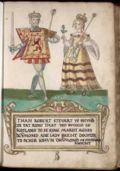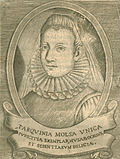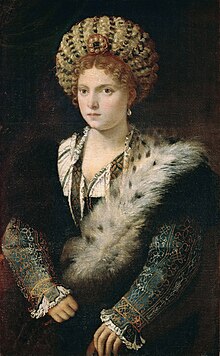List of 999 women on the Heritage Floor / Isabella d'Este
This list describes the place setting for Isabella d'Este on the table of Judy Chicago's art installation The Dinner Party . It is part of the list of 999 women on the Heritage Floor who are assigned to the respective place settings on the table. The names of the 999 women are on the tiles of the Heritage Floor, which is arranged below the table and belongs to the art installation.
description
The installation consists of a three-sided table, each with 13 historical or mythological personalities, thus a total of 39 people, from prehistory to the women's rights movement . These people were assigned a place setting at the table, consisting of an individually designed table runner, an individually designed plate, a goblet, knife, fork, spoon and serviette. The first page of the table is devoted to prehistory up to the Roman Empire , the second to Christianization up to the Reformation and the third from the American Revolution to the women's movement. Each place setting on the table is assigned additional personalities who have received an entry on the tiles of the Heritage Floor, which occupies the space under the table and the center of the space between the sides of the table. This list includes the personalities assigned to Isabella d'Este's place setting. Your seat is on the second side of the table.
Hints
In addition to the names as they are used in German transcription or in scientific usage, the list shows the spelling chosen by Judy Chicago on the tiles.
The information on women who do not yet have an article in the German-language Wikipedia is referenced by the individual references listed under comments . If individual information in the table is not referenced via the main article, additional individual references are given at the relevant point. If there are any discrepancies between the information provided in Wikipedia articles and the descriptions of the work of art on the Brooklyn Museum website , this will also be indicated under Comments.
Place setting for Isabella d'Este
Isabella d'Este was born in Ferrara on May 18, 1474as the daughter of Ercole I d'Este , Duke of Ferrara, and Leonora of Naples. Together with her siblings, she was taught Latin, music, dance, Greek and Roman history, and classical literature. She was very interested in astrology and studied maps, as well as playing chess and card games. In February 1490 she married Gianfrancesco II Gonzaga , Margrave of Mantua , with whom she had eight children. She ruled the margraviate several times. So from 1489 to 1498, when Gianfrancesco wasactive as a military commanderfor the Republic of Venice , 1509 to 1510, when he was in Venetian captivity, which she was able to end with diplomatic means and after his death in 1519 until her son Federico II. Gonzaga was able to take over the affairs of state.
It is thanks to their talent that Mantua's political position improved. Mantua became a duchy in 1530 and the appointment of her younger son Ercole cardinal in 1527 was also due to her efforts. In order to support her sons, she sent them to important European royal courts for training. This practice went back to her experience when her eldest son Federico had to be taken hostage for his father at the court of Julius II in Rome in 1510 , which, however, had a positive effect on his upbringing. Another side aspect were the connections that developed through the stay at the court. After Federico's return from Rome, she sent him to the court of the French king and her son Ferrante to the court of Charles V. This enabled the Gonzaga family to network with the important centers of power.
Isabella d'Este traveled to Rome in 1525 to campaign for a cardinal title for her son Ercole. Even after this was settled, Isabella stayed in Rome to enjoy the cultural and social life. She was still in Rome when the runaway mercenary troops of Charles V attacked, murdered and plundered Rome in the Sacco di Roma . Isabella organized the Palazzo Colonna into a defensive bastion and gathered over 2000 nobles and their servants there. She hoped that her son Ferrante, who served in Charles V's army, could protect her along with others. By paying ransom, she was able to keep the palace free from looters and organized the group's escape across the Tiber with the help of boats . Isabella finally reached Mantua via Genoa, where the group was safe.
Isabella d'Este is considered to be the most important art patron of the Renaissance . Her extensive correspondence, around 28,000 letters to Isabella and copies of around 12,000 letters that she wrote, document her work. She promoted painting by commissioning famous artists, as well as sculpture, employed master builders, was in contact with humanities scholars and supported composers and musicians. In fashion, she was considered a role model of her time. Their fashion was copied in Italy and at the French court.
The place setting for Isabella d'Este takes up two essential traits of her, her role as ruler in Mantua and as a patron of the arts. Your plate is in the colors gold, white and royal blue, in the style of Urbino majolica , which was also promoted by Isabella d'Este. The golden elements are raised and form a structural framework for the design. In the middle of the plate there is a circle in which colonnades are shown spatially. The plate takes up the techniques revived in the Renaissance for the creation of three-dimensional and realistic works by means of perspective , horizon lines and vanishing points . The outer rim of the plate is separated by six arch elements and designed by four ladder elements and two flower elements. The table runner has three different lily patterns on the front and the coat of arms of the d'Este family, decorated with tassels, on the back. The sides are designed with shields, Chicago chose blue as the background color for the designed areas, the decorative elements are edged in gold and the middle of the runner is kept white. The initial letter “I” on the front is surrounded by a flower-like shape that also takes up the colors of the runner.
| Surname | Spelling on the tile | Date of birth | cultural spatial assignment | Remarks | image |
|---|---|---|---|---|---|
| Agnes Sorel | Agnes Sorel | around 1422 | Kingdom of France | First known mistress of the French King Charles VII. |

|
| Alessandra Giliani | Alessandra Giliani | 1307 | University of Bologna | Said to have been the first woman to work as an anatomist or pathologist . Her life data are only very rudimentary documented, so that it can also be that she is a fictional personality. |

|
| Annabella Drummond | Annabella Drummond | 1350 | Scotland | Queen of Scotland. |

|
| Anne de Beaujeu | Anne of Beaujeu | 1461 | House of Bourbon | After the death of her father on August 30, 1483 to 1491, Anne took over the reign of her underage brother Charles VIII. With the help of her husband and her father's advisers, she enforced royal power against revolts by the great feudal lords . |

|
| Anne de Bretagne | Anne of Brittany | 1477 | French Kingdom , Brittany | Was through their marriages Archduchess of Austria (1490–1491), Queen of France (1491–1498), Queen of Sicily and Jerusalem and again Queen of France (1499–1514) and Duchess of Milan . She became known among other things for her interest in the arts she sponsored. |

|
| Barbara Strozzi | Barbara Strozzi | 1619 | Republic of Venice | Singer (soprano) and composer of the Baroque . |

|
| Battista Malatesta | Baptista Malatesta | 1384 | Duchy of Urbino | Scholarly noblewoman, poet and speaker. | |
| Cassandra Fedele | Cassandra Fidelis | around 1465 | Republic of Venice | In the last decades of the Quattrocento she was the most famous scientist in Italy. |

|
| Caterina Cornaro | Caterina Cornaro | 1454 | Kingdom of Cyprus | The last queen of Cyprus. In 1489 she declared that she was a "daughter of St. Mark", thus handing control of Cyprus over to Venice. |

|
| Caterina Sforza | Caterina Sforzia | 1463 | Duchy of Milan | Italian nobleman and countess of Forlì and mistress of Imola, first with her husband Girolamo Riario and after his death as regent of their son Ottaviano. She wrote a book with recipes in chemistry (alchemy), medicine and pharmacy. |

|
| Dorotea Bucca | Dorotea Bucca | 1360 | University of Bologna | Doctor, took over the chair of medicine and philosophy at the University of Bologna from her father in 1390 and held it for 46 years until her death in 1436. |

|
| Elisabetta Gonzaga | Elisabetta Gonzaga | 1471 | Duchy of Urbino | She is one of the most famous women of the Italian Renaissance and was distinguished by her education, her artistic sense, her patronage and her unwavering attitude towards strokes of fate. |

|
| Francesca Caccini | Francesca Caccini | 1587 | Florence | Opera singer ( soprano ), composer and instrumentalist . She is one of the pioneers of the opera genre. Her opera La liberazione di Ruggiero dall'isola d'Alcina (1625) is considered to be the earliest surviving opera by a female composer. |

|
| Gaspara Stampa | Gaspara Stampa | 1523 | Republic of Venice | She is considered the greatest poet of the Italian Renaissance and is considered by many to be the greatest Italian poet of all time. | |
| Isabella | Isabella of Lorraine | around 1400 | Lorraine | Duchess of Lorraine . As the first wife of René I of Anjou , she was also a. a. Queen of Naples from 1435 to 1442 . |

|
| Isabella Andreini | Isabella Andreini | 1562 | Republic of Venice | Actress and writer. Her character, the Isabella role of the Commedia dell'arte , was named after her. |

|
| Isabella Cortese | Isabella Cortesi | 16th century | Italy | Alchemist (chemist) of the 16th century. |

|
| Joan of Flanders | Jeanne de Montfort | 1295 | Brittany | Duchess of Brittany through her marriage to Duke Johann IV. In 1342 she took over the defense of the besieged city of Hennebont . During the siege, she wore weapons and armor , commanded the defenders of the city and asked the women to cut off their skirts and take their safety into their own hands . |

|
| Jolanthe of Aragon | Yolanda of Aragon | 1379 | Duchy of Anjou | Heiress to Bar-Mousson, Lunel, Berre and Martigues; as the wife of Ludwig II. Duchess of Anjou. Jolanthe was called Queen of the Four Kingdoms. |

|
| Catherine of Genoa | Catherine Adorni | 1474 | Genoa | Italian Roman Catholic saint and mystic, admired for her work among the sick and poor, recalling various scriptures describing both these acts and her mystical experiences. |

|
| Laura Battiferri | Laura Ammanati | 1523 | Florence | Poet of the Cinquecento and wife of sculptor and architect Bartolomeo Ammannati . |

|
| Laura Cereta | Laura Cereta | 1469 | Brescia | Scholar and writer of humanism. |

|
| Lucrezia Borgia | Lucrezia Borgia | 1480 | Duchy of Ferrara | Italian-Spanish Renaissance princess , illegitimate daughter of Pope Alexander VI. and Vanozza de 'Cattanei , sister of Cesare , Juan and Jofré Borgia . |

|
| Lucrezia Tornabuoni | Lucrezia Tournabuoni | 1425 | Florence | Poet, wife of the banker and Florentine politician Piero di Cosimo de 'Medici . |

|
| Maria de 'Medici | Marie de Medici | 1575 | Kingdom of France | Wife of the French King Henry IV , mother of Louis XIII. After the assassination of Heinrich IV. In 1610, she took over the reign of the still underage crown prince for several years . |

|
| Mathilde | Mahaut of Artois | 1268 | Artois county | Countess of Artois , Countess Palatine of Burgundy and Peer of France . |

|
| Mechthild from the Palatinate | Mathilda of Germany | 1419 | Archduchy of Austria | Princess of the Electoral Palatinate , Countess of Württemberg and Archduchess of Austria, closely associated with the educational movement of early humanism . |

|
| Novella d'Andrea | Novella D'Andrea | 1312 | University of Bologna | Law scholar and professor of law at the University of Bologna . | |
| Olympia Fulvia Morata | Olympia Morata | 1526 | Ferrara and Heidelberg | Poet and humanist scholar. Her "achievements led the tradition of Italian humanists to the other side of the Alps, where there were previously few such women". (Margaret L. King) |

|
| Tarquinia Molza | Tarquinia Molza | 1542 | Modena | Musician and poet. |

|
| Tullia d'Aragona | Tullia D'Aragona | around 1510 | Rome | Courtesan as well as poet and philosopher of the Renaissance . |

|
| Veronica Gambara | Veronica Gambara | 1485 | Duchy of Milan | Poetess . Married to Giberto X., Lord of Correggio. After his death in 1518, she ruled the small city-state with skill, even if she was more inclined to a contemplative life. |

|
| Vittoria Colonna | Vittoria Colonna | 1492 | Rome | Through her marriage to the Marquis of Pescara , a successful military leader, she became a Margravine. After his death as a result of being wounded in battle, she remained a widow and childless and devoted herself to cultural and religious tasks. She had a close friendship with Michelangelo . |

|
- Individual evidence
- ↑ Brooklyn Museum: Isabella d'Este. In: brooklynmuseum.org. Retrieved October 26, 2019 .
- ^ Brooklyn Museum: Baptista Malatesta. In: brooklynmuseum.org. Retrieved October 25, 2019 .
- ^ Brooklyn Museum: Dorotea Bucca. In: brooklynmuseum.org. Retrieved October 25, 2019 .
- ↑ Brooklyn Museum: Isabella Andreini. In: brooklynmuseum.org. Retrieved October 25, 2019 .
- ^ Brooklyn Museum: Novella D'Andrea. In: brooklynmuseum.org. Retrieved October 25, 2019 .
Web links
- Brooklyn Museum, Isabella d'Este
- The Dinner Party on the website of Through the Flower , Judy Chicago's non-profit organization
